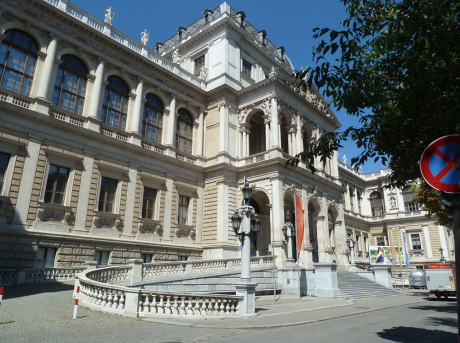Last week about 200 scientists from 29 countries met in Vienna for the 6th Metallomics symposium.
After the
last conference in Beijing, this issue brought the symposium back to Europe.
With respect to participation, the 6th issue could not attract as many
participants as former events (Nagoya: 400, Münster: 320, Oviedo: 280). Anyhow,
the scientific program was interesting and mirrored nicely the
interdisciplinary area of metallomics with contributions from analytical
scientists as well as researchers from life science. Most foreign researchers came from Germany
(29), Japan (25), UK (13), Spain (11), China (10), Poland (8) and USA (8).

Photo: Vienna University
The
symposium was opened already on Sunday late afternoon in the historical
"large ceremonial chamber" of the main building of the University
with welcoming words by the conference chairs Gunda Koellensperger and Bernhard
Keppler. Two invited lectures by Bob Crichton ("A journey through the
world of iron") and Christian Obinger ("From innate immunity to
hormone and extracellular matrix biosynthesis - how posttranslational
modifications of the heme cofactor modulate catalysis of human
peroxidases") introduced into the field of metallomics.
The format
of the symposium starting on Monday followed a two stream set with invited
lectures introducing the topic of the session. Ryszard Lobinski reviewed the
analytical chemistry tools for metallomics while Thomas Walczyk discussed the
brain iron uptake. The participants had to select where to go, since Tanja
Schwerdtle opened the parallel stream by discussing the toxicological
characterization of arsenolipids.
A short
coffee break served in the inner yard of the university gave the opportunity to
appreciate the nice weather, to contact the exhibitors or to chat with other
participants.
The second
session was opened by Maria Montes-Bayon with a presentation on nanostructured
metallodrugs. Again the parallel session was devoted to toxicology and opened
by Yasumitsu Ogra with a report on the toxicology of tellurium.
After the
lunch break in the inner yard, the participants had the first opportunity to
look at the posters which were exposed during the whole symposium.
The first
afternoon session was opened by Clay Davis discussing the development of
reference materials for metalloprotein measurements. Again the parallel session
was devoted to toxicology, this time opened by Seiichiro Himeno, who discussed
renal toxicity of heavy metals.
The second
afternoon session devoted to analytical techniques was opened by Heidi Goenaga
Infante who discussed the Interaction of Oxide Nanoparticles with Biological
Systems. This time, the participants had a harder time to select the stream,
since the parallel stream discussed very similar topics. Chunying Chen opened
the parallel steam by discussing synchrotron-based techniques to study the
interaction of nanoparticles with living systems. Unfortunately, it was not
very easy to change from one stream to the other, since there was no time to
change and also the timetable was not strictly followed.
After a
long day, the participants had the opportunity to follow one of the short
courses introducing into imaging techniques or tracer studies.
Tuesday was
only partly devoted to the scientific program, since the afternoon was free for
visiting Vienna. Norbert Jakubowski reported about metal detection at cellular levels, and Uwe Karst discussed the use of complementary techniques for imaging.
Two further short courses introduced to elemental speciation and toxicology.
In the
evening, most of the participants came together for the conference dinner that
took place at the "Heurigen Welser". The perfect weather allowed to
appreciate the young wine and the local style food during the whole evening
outside in the garden.
After such a relaxing evening, it was certainly not easy to start the next day early in the
morning at 8:15. Walter Berger had this difficult task to open the morning
session related to metal based drugs with a discussion of molecular mechanisms
of resistance against anticancer drugs.
The session
was continued after the coffee break with an invited lecture by Paul Dyson on
"the influence of RAPTA-T on the tumour microenvironment". A parallel
session on plant metallomics was opened by Soren Husted, who discussed
LA-ICP-MS bioimaging for plant samples.
The first
afternoon session on Wednesday was opened by Angela Casini with a presentation
on "supramolecular self-assembled metallacages for biomedical
applications. In the parallel session, Xinrong Zhang reported how ICP-QQQ-MS
could be used to study organic reactions.
The second
afternoon sessions related to metals in medicine was opened by Frank Vanhaecke,
who discussed how isotope ratio variations could be used for medical diagnosis.
The parallel session on applications was opened by Qiuquan Wang with a report
on metal tagging for PTMs analysis. Unfortunately, the parallel session was not
even scheduled to be synchronized, so that changing over between the two
streams was nearly impossible.
The first
session of the last day was opened by Christian Hartinger with a report on the
development of anticancer metallodrugs. Peter Faller opened the parallel
session devoted to bioinorganic chemistry with a discussion of amyloidogenic
peptides. The last morning session devoted to imaging was introduced by Joanna
Collingwood with a report on the role of metals in neurodegenerative disorders.
The last
afternoon sessions were opened by David Giedroc with a contribution discussing
the mechanisms of zinc metallostasis in bacterial pathogens. While we here
reported only from invited lectures, the lively discussion during the symposium
was mainly driven by the many contributed presentations and discussions related
to them. The symposium was closed by announcing the awardees for the poster
awards and some farewell wishes by the symposium chairs. Unfortunately, the
chair for the next symposium could not be announced since no bids were
submitted. We therefore would like to motivate all interested parties to submit
their offer to organize the next symposium to Gunda Koellensperger.
Michael Sperling
 Related EVISA Resources
Related EVISA Resources
 History of Speciation Conferences
History of Speciation Conferences
 Related EVISA News
Related EVISA News
 September 19, 2015: Impressions from the 5th Metallomics Symposium
September 19, 2015: Impressions from the 5th Metallomics Symposiumlast time modified: September 23, 2024